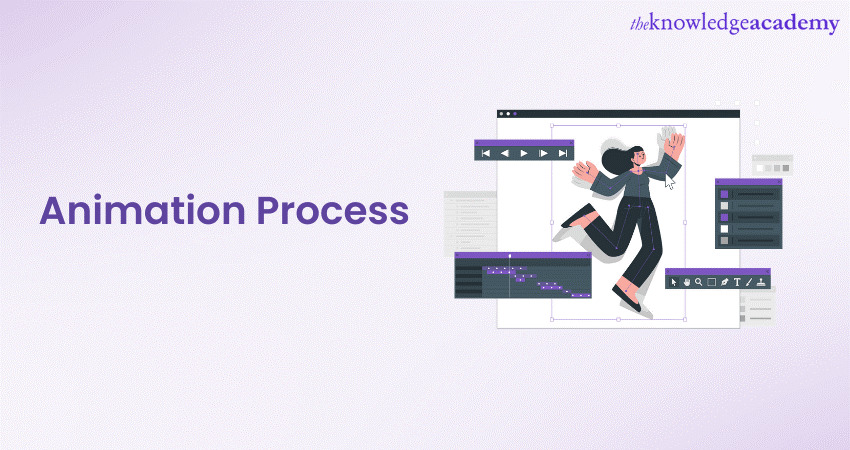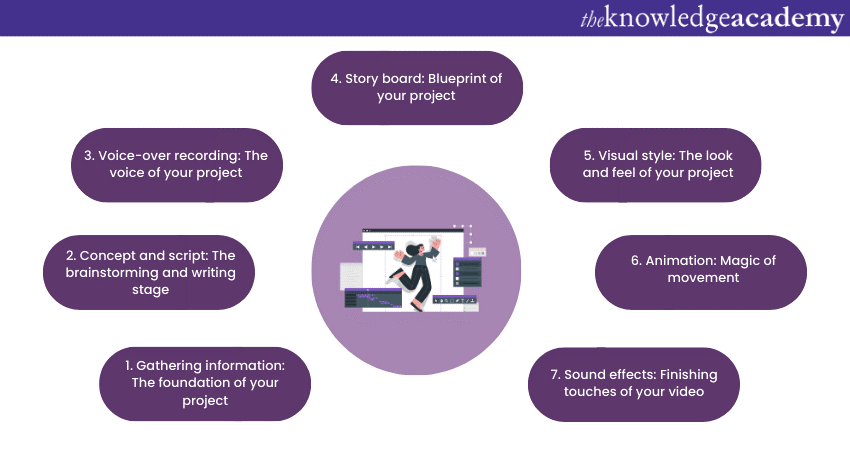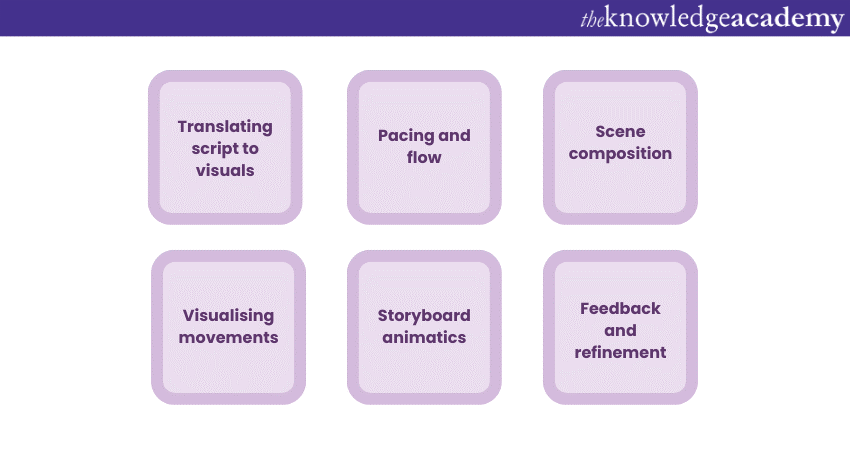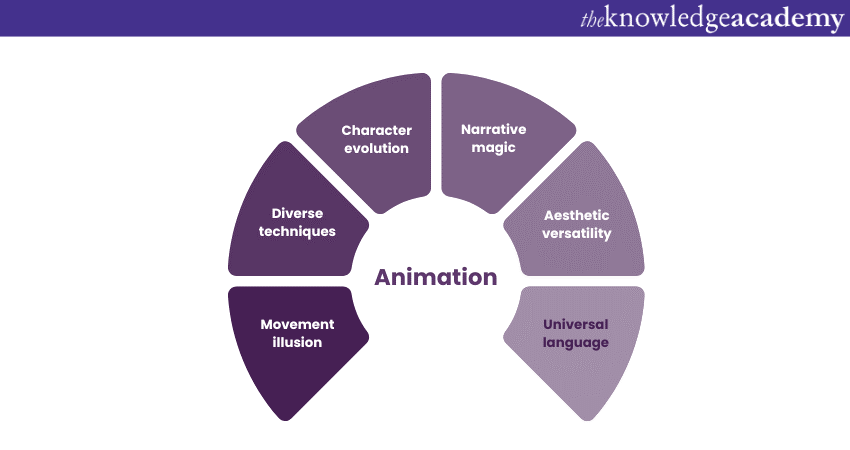We may not have the course you’re looking for. If you enquire or give us a call on +31 208081674 and speak to our training experts, we may still be able to help with your training requirements.
We ensure quality, budget-alignment, and timely delivery by our expert instructors.

Animation is a captivating art form that brings characters and stories to life through motion and creativity. Have you ever wondered how is your favourite animated movies or shows made? It is all done through a carefully developed Animation Process.
According to Statista, the global Animation market increased by five per cent to over 292 billion GBP in 2021. Read this blog to learn about the various steps and stages involved in the Animation Process and how they help create Animation that attracts viewers' attention.
Table of Contents
1) Animation Process: Step-by-step guide
a) Gathering information: The foundation of your project
b) Concept and script: The brainstorming and writing stage
c) Voice-over recording: The voice of your project
d) Storyboard: Blueprint of your project
e) Visual Style: The look and feel of your project
f) Animation: Magic of movement
g) Sound effects: Finishing touches of your video
2) Things to keep in mind during the Animation Process
3) Conclusion
Animation process: Step-by-step guide

Animation is an artistic technique that brings static images to life through rapid changes. Creating a series of individual frames and playing them quickly creates the illusion of movement, captivating viewers' senses and imagination. It is a versatile medium that ranges from traditional hand-drawn art to modern computer-generated graphics.
Animation, including 2D Animation, is not limited to entertainment; it is a powerful tool for storytelling, education, and communication. Through careful manipulation of visuals, timing, and sound, animators craft characters, scenes, and narratives that evoke emotions, convey messages, and transport audiences to fictional worlds, making it a timeless and enchanting art form. The following are the various steps and stages of the Animation Process.
Unlock your creative potential with our Animation and Design Training – Join now to bring your imagination to life!
Gathering information: The foundation of your project
The first step in the Animation Process is "Gathering Information," a stage that lays the groundwork for the entire project. This phase involves meticulous research, brainstorming, and creativity to shape the direction and essence of the project.
a) Objective and audience: Define your purpose, whether educational, promotional, or entertainment. Understand your target audience's preferences and demographics to tailor your approach.
b) Research and inspiration: Study successful Animations in your genre to gather insights into narrative structures and engagement strategies. Use this research for inspiration.
c) Conceptualisation: Brainstorm and refine unique ideas that align with your goals. Craft a central concept or theme that forms the core of your Animation.
d) Storyboard blueprint: Create rough storyboard frames to visualise scene flow and transitions. This early sketching helps outline the Animation's structure.
e) Resource collection: Gather reference materials like images and videos to ensure accurate depictions of characters, settings, and contexts.
f) Feedback loop: Seek input from peers or mentors to refine your concept and sketches. Incorporate valuable feedback to enhance your project's quality.
Concept and script: The brainstorming and writing stage
The "Concept and script" phase is a creative part where your Animation's brainstorming and writing stage takes place. It involves shaping abstract ideas into a tangible narrative structure that will guide the Animation's storyline and characters.
a) Idea refinement: Building upon the gathered information, dig into your chosen concept more extensively. Refine the central theme, message, and emotional resonance you want your Animation to convey.
b) Character development: Craft compelling characters that are relatable and multi-dimensional. Define their personalities, motivations, and arcs, breathing life into them before they even hit the screen.
c) Script crafting: Translate your refined concept into a well-structured script. Outline scenes, dialogue, and pacing, ensuring a coherent and engaging narrative flow.
d) Visualising scenes: Collaborate with storyboard artists to visualise the script through rough sketches. This collaboration between writing and visuals enhances scene planning and paves the way for Animation.
e) Balancing dialogue and action: Aim for a balanced mix of dialogue, character interactions, and visual storytelling. Each element should complement the other, enriching the viewer's experience.
f) Iterative process: Expect multiple script iterations, refining dialogues, and interactions to capture the desired emotions and nuances.
Learn how to work with colours in Sketchbook with our Sketchbook Essential Training. Join now!
Voice-over recording: The voice of your project
The recording through Voice Over is a step that adds a soulful dimension to your Animation, giving voice and personality to the characters you've meticulously crafted. This auditory layer includes emotions, nuances, and authenticity in the narrative fabric.
a) Casting the right voices: Carefully select voice actors whose vocal qualities align with the character’s traits and personalities. A distinct voice can make characters relatable and unforgettable.
b) Directing the performance: Collaborate closely with voice actors, guiding them to capture the desired emotional range and nuances. Directing ensures the characters' voices resonate authentically.
c) Recording environment: Create an acoustically controlled environment to ensure clean and high-quality recordings. This step is vital to maintain audio clarity and eliminate unwanted noise.
d) Lip-Sync considerations: If applicable, synchronie dialogue with character movements to achieve realistic lip movements. This synchronisation adds a layer of believability to the characters' interactions.
e) Emotional resonance: Encourage voice actors to infuse their performances with the emotions required for each scene. A skilful voice actor can convey a character's feelings, enhancing audience connection.
f) Sound engineering: post-recording, engage in sound engineering to balance audio levels, remove imperfections, and optimise the voice track for seamless integration into the Animation.
Unleash your artistic flair in the world of Animation – Join our 2D Animation Training and craft captivating stories through motion and imagination!
Storyboard: Blueprint of your project

The "Storyboard" phase is an art that bridges imagination and visualisation, transforming the script's words into a visual roadmap. It acts as the foundation for your Animation, providing a clear and organised blueprint for every scene and camera angle.
a) Translating script to visuals: Collaborate with artists to translate the script's essence into rough sketches. Each frame captures a moment, depicting the character’s expressions, actions, and settings.
b) Pacing and flow: Arrange the storyboard panels to ensure smooth pacing and narrative flow. The placement of each shot contributes to the Animation's rhythm and emotional impact.
c) Scene composition: Determine camera angles, compositions, and shot sizes to enhance storytelling. The arrangement of elements within each frame guides viewers' focus and emotions.
d) Visualising movements: Showcase character movements through a sequence of frames. This visual progression guides animators in creating fluid and coherent motion.
e) Storyboard animatics: Animate the storyboard frames, creating a rough animatic that simulates the Animation's timing and visual dynamics. This pre-visualisation aids in identifying potential issues before total production.
f) Feedback and refinement: Share the storyboard with collaborators to gather feedback and insights. Refine the panels based on suggestions, ensuring a cohesive and compelling visual narrative.
Elevate your Animation skills to new heights with our immersive Animation Masterclass – Join today and embark on a journey of creative excellence!
Visual Style: The look and feel of your project
The "Visual Style" phase is where the Animation's aesthetics and atmosphere come into play, giving form to the characters and world you have envisioned. It is a creative playground where artistic choices define its look, tone, and emotional impact.
a) Designing characters: Create detailed character designs that embody their personalities and traits. Consider their proportions, facial expressions, and attire, ensuring visual consistency throughout.
b) Background art: Develop captivating backgrounds that immerse viewers in the Animation's setting. Whether fictional or mundane, backgrounds affect mood and context, enriching the storytelling.
c) Colour palette: Choose a colour palette that resonates with the Animation's theme and emotions. Colours affect feelings and set the tone, influencing how audiences perceive and connect with the narrative.
d) Visual references: Gather visual references to ensure accuracy and authenticity in depicting real-world elements. Reference materials enhance the Animation's realism and credibility.
e) Textures and details: Add textures and intricate details to characters, props, and environments. These visual nuances breathe life into the Animation, enhancing its tactile and sensory appeal.
f) Stylistic choices: Embrace a specific visual style, photorealism, minimalism, or a unique hybrid. Consistency in style reinforces the Animation's identity and captivates audiences with its distinctiveness.
Learn how to create Motion Graphics with our Motion Graphics Masterclass. Register yourself today!
Animation: Magic of movement

Animation is the art of adding life to static images through a sequence of rapid visuals. It encompasses an array of techniques, from traditional hand-drawn frames to cutting-edge CGI and 2D animation software, each contributing to its diverse and captivating nature. Through it, characters gain emotions and personalities, becoming conduits for storytelling and universal messages.
a) Movement illusion: Animation is creating the illusion of movement through a series of images displayed in rapid succession.
b) Diverse techniques: From classic hand-drawn frames to cutting-edge computer-generated imagery (CGI), it spans a broad spectrum of techniques, each offering unique visual appeal.
c) Character evolution: Through Animation, characters evolve from sketches to vibrant personas, capable of expressing emotions, thoughts, and narratives.
d) Narrative magic: It is a powerful storytelling medium, crafting intricate plots and evoking emotions through visually captivating sequences.
e) Aesthetic versatility: Animators harness various visual styles, ranging from realistic to abstract, allowing them to adapt aesthetics to the project's theme and mood.
f) Universal language: Crossing cultural and linguistic barriers, Animation's emotive visuals forge connections and resonate with diverse audiences.
Understand how to create 3D models in Blender with our comprehensive Blender Creator Training. Join now!
Sound effects: Finishing touches of your video
Sound effects, an integral part of Animation, breathe life into visuals, enriching the viewer's experience through auditory immersion. This intricate audio layer enhances storytelling and adds depth to characters and scenes, creating a multi-sensory journey.
a) Atmospheric ambience: Sound effects establish the ambience of a scene, whether it is the rustling leaves of a forest or the bustling streets of a city, drawing audiences deeper into the Animation's world.
b) Character identity: Every footstep, giggle, or sigh lends a distinct identity to characters, conveying emotions and personalities that complement their visual depiction.
c) Action intensity: The swoosh of a cape or the clang of swords intensifies action sequences, creating suspense and lending realism to animated battles.
d) Environmental realism: Sound effects mirror real-world intricacies, from the crunch of snow underfoot to the gentle lapping of waves, creating a sense of authenticity.
e) Emotional resonance: Whispers, laughter, or heartbeats evoke emotions, bridging the emotional gap between the animated world and the audience's hearts.
f) Narrative enhancement: Sound effects synchronise with visuals, underscoring pivotal moments, building tension, and highlighting plot twists, enhancing the storytelling arc.
Acquire necessary skills in creating, duplicating, and transforming objects with our Architectural Design And Animation In Blender Training.
Things to keep in mind during the Animation Process
As you start your journey of Animation, several vital considerations can elevate your creative process and ensure a successful outcome. From conceptualisation to finishing touches, these insights provide a compass to navigate the intricate realm of Animation:
a) Consistent visual language: Maintain a cohesive visual style throughout to enhance immersion and coherence.
b) Emotion-driven movements: Infuse character actions with genuine emotions to forge stronger connections with the audience.
c) Pacing and timing: Carefully calibrate timing between frames for smooth motion and impactful storytelling.
d) Sound synchronisation: Ensure sound effects and dialogue align seamlessly with visual cues to enhance realism and engagement.
e) Iterative refinement: Embrace an iterative approach, welcoming feedback and making necessary adjustments to enhance quality.
f) Attention to detail: Pay meticulous attention to minute details, as they contribute to authenticity and believability.
g) Storyboard as a guide: Rely on the storyboard as your visual roadmap, to maintain consistency and narrative flow.
h) Test and iterate: Regularly test Animation sequences to identify any glitches or improvements needed for a polished result.

Conclusion
In the age of Animation, creativity walks along with technology, shaping dreams into mesmerizing realities. Every meticulous step contributes to the symphony of motion and emotion. Through the fusion of visuals, sound, and narrative, it captivates hearts and minds alike. Armed with newfound insights, you are ready to start your own journey of the Animation Process, where imagination knows no bounds and stories come alive with every frame. As you embark on this journey, you’ll find that AI Animation Generators are powerful tools that can assist you in turning your ideas into fully realized animations.
Learn how to write articulate stories with our comprehensive Articulate Storyline Training. Join today!
Frequently Asked Questions
Upcoming Office Applications Resources Batches & Dates
Date
 Articulate Storyline Training
Articulate Storyline Training
Fri 14th Mar 2025
Fri 9th May 2025
Fri 11th Jul 2025
Fri 12th Sep 2025
Fri 14th Nov 2025






 Top Rated Course
Top Rated Course


 If you wish to make any changes to your course, please
If you wish to make any changes to your course, please


